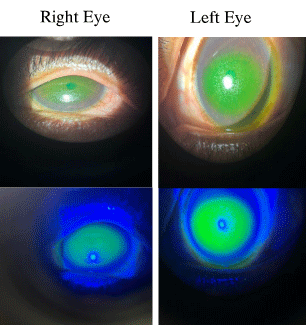More Information
Submitted: January 17, 2025 | Approved: June 20, 2025 | Published: June 23, 2025
How to cite this article: Chellakumar V. Custard Apple Seed Induced Bilateral Toxic Keratoconjunctivitis - A Case Report. Int J Clin Exp Ophthalmol. 2025; 9(1): 018-019. Available from:
https://dx.doi.org/10.29328/journal.ijceo.1001062.
DOI: 10.29328/journal.ijceo.1001062
Copyright Licence: © 2025 Chellakumar V. This is an open access article distributed under the Creative Commons Attribution License, which permits unrestricted use, distribution, and reproduction in any medium, provided the original work is properly cited.
Keywords: Corneal epithelial defect; Keratoconjuctivitis; Custard apple seed powder
Custard Apple Seed Induced Bilateral Toxic Keratoconjunctivitis - A Case Report
Vikram Chellakumar*
Associate Professor of Ophthalmology, Sree Balaji Medical College and Hospital, Chromepet, Chennai - 600 044, India
*Address for Correspondence: Dr. Vikram Chellakumar, Associate Professor of Ophthalmology, Sree Balaji Medical College and Hospital, Chromepet, Chennai - 600 044, India, Email: [email protected]
Custard apple is a tropical fruit that is cultivated all over India. The seeds of this fruit are found to have medicinal properties as they contain active compounds such as alkaloids, cyclohexapeptides, and acetogenins. It has been used in powdered form for the treatment of scalp lice and dandruff in our part of the world as a native medicine for a long time. We report a case of bilateral severe toxic keratoconjunctivitis following accidental exposure to custard apple seed powder.
Custard apple is a tropical fruit that is cultivated all over India, particularly in South India. It is also called a sugar apple due to its sweet taste [1]. Custard apple seeds have been found to have medicinal properties like as anti-HIV activity, antidiabetic, antioxidant, antitumor activity, wound healing effects, insecticidal, antifungal, anti-lice, and mosquitocidal properties [2]. Custard apple seeds have been used in powdered form for the treatment of scalp lice and dandruff in our part of the world as native medicine for a long time [1,2]. We report a case of bilateral toxic keratoconjunctivitis following accidental exposure to custard apple seed powder.
A 56-year-old female patient presented to our OPD with complaints of severe pain, redness, photophobia, and defective vision in both eyes of one day duration. She gave a history of using custard apple seed powder on her scalp, which had entered her eyes while having a bath, following which she developed severe irritation in both her eyes and later developed pain and photophobia accompanied by blurred vision over the next few hours. She came to us the following day. Ocular examination showed bilateral lid edema, conjunctival congestion, and corneal epithelial defect measuring 8/8 mm in the right eye and 7/6 mm in the left eye, stromal edema with DM folds were also present. Her visual acuity was 5/60 in the right eye and 6/36 in the left.
The patient was treated with hourly antibiotic (Moxifloxacin 0.4%) and lubricant eye drops. Cycloplegic drops (Homatropine 0.5%) were given for pain. Both her eyes were patched at bedtime after applying an antibiotic (gatifloxacin) ointment. The patient showed significant improvement in symptoms after three days of treatment, and antibiotics and lubricants were tapered to four times a day and continued for a week. The patient’s condition resolved with a clear cornea at the end of 1 week.
Custard apple is the fruit of Annona squamosa, which belongs to the genus Annona and family Annonaceae. Seeds of this tropical fruit contain active compounds such as alkaloids, cyclohexapeptides, and acetogenins. Annonaceous acetogenins are responsible for their medicinal effects [2-4]. However, it is toxic to ocular structures, especially corneal epithelium, probably due to the various chemicals it contains, leading to chemical toxicity. It can cause corneal erosions, abrasions, leading to secondary bacterial infections [3-5]. It was first reported by Allen, an American botanist, and further studies done on rabbit eyes showed that it caused conjunctival inflammation and corneal epithelial damage [6].
The pathogenic mechanism is related to poor adhesion of the corneal epithelium to the underlying stroma and excessive matrix metalloproteinase activity [3]. Nagaraja, et al. have shown that steroids should be avoided in these patients, particularly in the early phase of wound healing. In another study, Prathiba Devi Nivean, et al. suggested that patching can help in faster recovery, as constant lid movement can also worsen this condition.
This case is being reported to create awareness of the toxic effects of custard apple seeds, which are widely used as a native medicine, and how to treat accidental exposure.
- Dastur JF. Medicinal Plants of India and Pakistan. Bombay: D.B. Taraporevala Sons; 1962. Available from: https://opac.narc.gov.np/opac_css/index.php?lvl=notice_display&id=2258
- Nagaraja H, Kugar T, Shivanna Y, Agrawal A, Shetty R. Ocular toxicity by seeds of Annona squamosa (custard apple). Indian J Ophthalmol. 2016;64:611-3. Available from: https://doi.org/10.4103/0301-4738.191514
- Devi Nivean P, Malarkodi S, Nishanth M, Nivean M. Custard apple seed induced keratitis: A harmful traditional practice in South India. GMS Ophthalmol Cases. 2017;7:Doc23. Available from: https://doi.org/10.3205/oc000074
- Gandhi P, Radhakrishnan N, Khaitan I, Srinivasan M, Prajna VN. Toxic keratitis after application of custard apple seed for head lice infestation. Cornea. 2019;38:948-50. Available from: https://doi.org/10.1097/ico.0000000000001981
- Gonde (Ballamwar) P. Custard apple seeds induced toxic keratoconjunctivitis. Glob J Cataract Surg Res Ophthalmol. 2024;3:116-8. Available from: https://gjcsro.com/custard-apple-seeds-induced-toxic-keratoconjunctivitis/
- Allen PH. Poisonous and injurious plants of Panama. Am J Trop Med Hyg. 1943;23:76. Available from: https://www.cabidigitallibrary.org/doi/full/10.5555/19432901017
